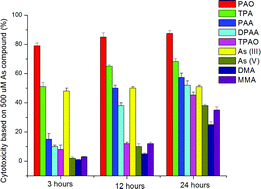The arsenic metallome in African Green Monkey kidney cells is probed by measuring cytotoxicity, cellular arsenic uptake and speciation studies on arsenic-containing chemical warfare agent degradation products (CWDPs) during cell uptake. Inorganic arsenic compounds and methylated species also were studied during cell uptake as a means of providing cytotoxicity information relative to the CWDPs. The degradation products used were phenylarsine oxide (PAO), phenylarsonic acid (PAA), diphenylarsinic acid (DPAA), triphenylarsine (TPA) and triphenylarsine oxide (TPAO). These are the warfare agent’s primary degradation products. The parent warfare agents (red agents) are diphenylarsine chloride (DA or referred to as Clark I) and diphenylarsine cyanide (DC or Clark II), sternutator agents, sneezing gases able to cause bronchial irritation. Cytotoxicity levels and cellular uptake were compared to those of inorganic species: sodium arsenite, NaAsO2 [As(III)], sodium arsenateNa2HAsO4 [As(V)] and methylated arsenicals such as dimethylarsinic acid (DMA) and methylarsonic acid (MMA). The arsenic uptake was demonstrated in an African Green Monkey kidney cell line, CV-1. Quantification of lactate dehydrogenase activityreleased from damaged/dying cells was then measured via an LDH assay. The purpose of this study is to initially investigate toxicity to cells when exposed to different arsenic containing compounds over different concentrations and time ranges from 3 h to 24 h. Furthermore, exposed cells were then analyzed for different arsenic species by high performance liquid chromatography (HPLC) with inductively coupled plasma mass spectrometry to isolate and speciate arsenic fractions followed by nanoLC electrospray ionization mass spectrometry to analyze the molecular level changes of the arsenic based degradation products in the kidney cells. Metabolic changes to the arsenic species were found, and interestingly, at the lowest uptake levels, cytotoxicities were generally higher for the chemical warfare agent degradation products than the inorganic arsenic species.

You have access to this article
 Please wait while we load your content...
Something went wrong. Try again?
Please wait while we load your content...
Something went wrong. Try again?


 Please wait while we load your content...
Please wait while we load your content...